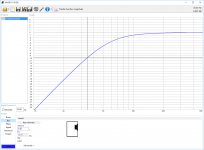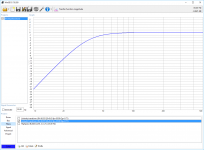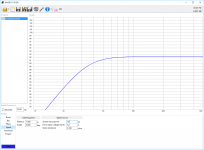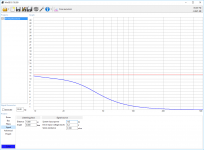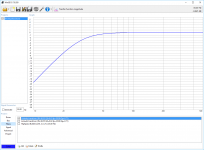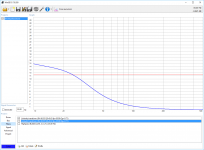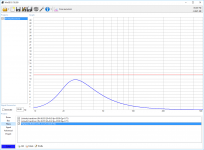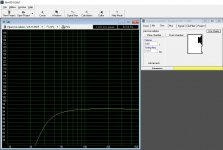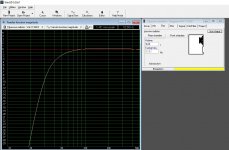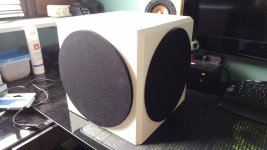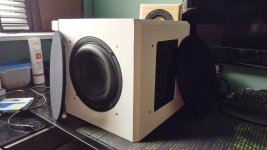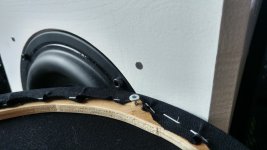I think the problem is that people want this driver to live up to the legend but without the costs.
It's a great sub and what I've learned from owning the 5.25" and 6.5" is that they are great for small applications and ones that can accommodate trade-offs.
If chuffing is an issue then you are driving it beyond what is reasonable given size restraints, ergo, buy a different sub, build a bigger cab, do it how it should be done for the requirements.
I like these drivers because they do provide a bit of a challenge, even though I'm a beginner. I've learned a lot of pitfall mistakes from these smaller drivers that if I master now, when I translate to larger projects I will understand the fundamentals of space restraints and physics.
It's a great sub and what I've learned from owning the 5.25" and 6.5" is that they are great for small applications and ones that can accommodate trade-offs.
If chuffing is an issue then you are driving it beyond what is reasonable given size restraints, ergo, buy a different sub, build a bigger cab, do it how it should be done for the requirements.
I like these drivers because they do provide a bit of a challenge, even though I'm a beginner. I've learned a lot of pitfall mistakes from these smaller drivers that if I master now, when I translate to larger projects I will understand the fundamentals of space restraints and physics.
If 30% of the port is removed after construction and gives that 30% back to the cabinet volume, how do you account for that? Slot ports are voluminous.
Note that it has a huge end correction, so has a much longer acoustic length, ergo quite a bit more voluminous than just the shelf volume.
GM

Yep, my mistake. I was thinking of the other one and thought it had that name.
Happy New Year,
Chris
I'm glad that this thread got an update. I was going to make a small cylinder-shaped box for this and go ported with a regular round port. The simulations showed that with little power I could go with the 2" port, but when the driver really starts to move, the air velocity will become an issue.
If I had the extra space, I would go with this design: http://volvotreter.de/downloads/TangBand_W6-1139SC_38Hz_TH_Rev_1.pdf
But this is going to my office and needs to be as small as possible, so I'll probably get the kit with passive radiators. It only costs 10€ more than the driver itself and I can build a compact 10 liter enclosure
PR14-C - 6.5" Subwoofer Bundle - TB SPEAKER CO., LTD.
If I had the extra space, I would go with this design: http://volvotreter.de/downloads/TangBand_W6-1139SC_38Hz_TH_Rev_1.pdf
But this is going to my office and needs to be as small as possible, so I'll probably get the kit with passive radiators. It only costs 10€ more than the driver itself and I can build a compact 10 liter enclosure
PR14-C - 6.5" Subwoofer Bundle - TB SPEAKER CO., LTD.
I am also thinking of building a desktop "subwoofer", or actually two - small bass stands for my desktop monitors. If any design seem to work out well.
Based on my initial investigation PR14-C bundle is also an option. However, as I already have miniDSP in my desktop setup, I was wondering if this driver or some other model would be suitable for sealed cabinet and Linkwitz transform? Any ideas?
I have 2x UcD180 amp unused so I could get decent amount of power as well if any of these small drivers can handle it. Anyway, sound levels are low so I could try to extend the lower end response a bit.
Based on my initial investigation PR14-C bundle is also an option. However, as I already have miniDSP in my desktop setup, I was wondering if this driver or some other model would be suitable for sealed cabinet and Linkwitz transform? Any ideas?
I have 2x UcD180 amp unused so I could get decent amount of power as well if any of these small drivers can handle it. Anyway, sound levels are low so I could try to extend the lower end response a bit.
It just so happens that I am building two sealed cabs for my two drivers today. A 7litre box, I'll keep you updated on my findings. I am hoping that room gain will make up for the roll off as my listening room is rather wild in its modes.
I am also thinking of building a desktop "subwoofer", or actually two - small bass stands for my desktop monitors. If any design seem to work out well.
Based on my initial investigation PR14-C bundle is also an option. However, as I already have miniDSP in my desktop setup, I was wondering if this driver or some other model would be suitable for sealed cabinet and Linkwitz transform? Any ideas?
I have 2x UcD180 amp unused so I could get decent amount of power as well if any of these small drivers can handle it. Anyway, sound levels are low so I could try to extend the lower end response a bit.
Great, looking forward to your results.
These stands would be under my Genelec 8020s, behind computer monitors. Height around 45cm and footprint somewhere 20x20cm max ballpark, and firing to the sides (as monitors would be in front of them).
Makes me still wonder whether these would give enough improvement. I could maybe squeeze in 8" drivers as well if something would work in that small box, and boost it with DSP again.
These stands would be under my Genelec 8020s, behind computer monitors. Height around 45cm and footprint somewhere 20x20cm max ballpark, and firing to the sides (as monitors would be in front of them).
Makes me still wonder whether these would give enough improvement. I could maybe squeeze in 8" drivers as well if something would work in that small box, and boost it with DSP again.
I think I will stick to these Tang Bands as they seem to be very versatile, folks have built all kinds of boxes - if this does not work out. Will need to try to simulate a sealed box first and estimate the LT effects, or can the sim tools do that? I have not simulated subs in many many years! Been just on electronics. The whole idea arose as I need new higher stands for my Genelecs due to smaller tabletop and speakers staying behind screens.
grahamgraham, did you find a UK dealer for Tang Bands? Quick search doesn't show any luck. blue planet acoustic in Germany is an option.
grahamgraham, did you find a UK dealer for Tang Bands? Quick search doesn't show any luck. blue planet acoustic in Germany is an option.
Ok, I did my 2-hour self-learning subwoofer design course and here are the first results. So bear with me and please point out if I have missed something 🙂
Idea is Linkwitz transformed sealed box. I chose 8.5 litres as it seems good size for my dimensions and enlarging from here doesn't really give much anymore in terms of lower end SPL.
1st image shows this starting point, 8.5 l sealed box. As can be seen, we are 10dB down at 35 Hz.
2: 35 Hz LT added. So we are boosting 10dB at 35 Hz and so also losing 10 dB of SPL, right?
3. SPL at 10 W, meaning at 35 Hz it is already 100 W. So kind of maximum SPL?
4. Cone excursion at 10 W. Still within limits. And I would use subsonic as well.
So this would give 92 dB which is plenty in a small room in near field. 35 Hz plus room should give some extra reach. This is of course simulation but I would also have two of these so that means more headroom.
Idea is Linkwitz transformed sealed box. I chose 8.5 litres as it seems good size for my dimensions and enlarging from here doesn't really give much anymore in terms of lower end SPL.
1st image shows this starting point, 8.5 l sealed box. As can be seen, we are 10dB down at 35 Hz.
2: 35 Hz LT added. So we are boosting 10dB at 35 Hz and so also losing 10 dB of SPL, right?
3. SPL at 10 W, meaning at 35 Hz it is already 100 W. So kind of maximum SPL?
4. Cone excursion at 10 W. Still within limits. And I would use subsonic as well.
So this would give 92 dB which is plenty in a small room in near field. 35 Hz plus room should give some extra reach. This is of course simulation but I would also have two of these so that means more headroom.
Attachments
Another example with 30 Hz LT.
1. Fc at 30 Hz but now we are boosting already 12 dB meaning 16 times the power.
2. Cone excursion gets too high - but only below 30 Hz.
3. 22 Hz 4th order high-pass filter added, this keeps excursion within limits but does not really show in magnitude response.
Here used 10 W is already too much as we have 12 dB boost. Anyway, it kinda works on paper but is maybe too close to limits and pushing too far. Although again I would have two drivers giving some more headroom.
Anyway, based on these findings I could build two small sealed boxes and then experiment LT and HP with DSP, do measurement including the room and adjust. Could work! Unless I have completely missed something as I am new to this..
1. Fc at 30 Hz but now we are boosting already 12 dB meaning 16 times the power.
2. Cone excursion gets too high - but only below 30 Hz.
3. 22 Hz 4th order high-pass filter added, this keeps excursion within limits but does not really show in magnitude response.
Here used 10 W is already too much as we have 12 dB boost. Anyway, it kinda works on paper but is maybe too close to limits and pushing too far. Although again I would have two drivers giving some more headroom.
Anyway, based on these findings I could build two small sealed boxes and then experiment LT and HP with DSP, do measurement including the room and adjust. Could work! Unless I have completely missed something as I am new to this..
Attachments
Last edited:
That LT project is interesting. Only thing that comes to my mind is the power and heat, will the driver get too hot? It's a small and sealed box so it can't breathe at all. But with moderate output it might be ok. Here's a good LT project also: Linkwitz Transform Subwoofer Equaliser
I simulated my box with passive radiators and I think I'll go with this one. I'm planning on using a spare LM1876 chipamp for power, so not much reserve there. If the amp goes to it's limits too fast, I might need to consider some class-d amp instead.
The simulation is done with 20 watts input, 9 liter box and no mass added to PR's.
I simulated my box with passive radiators and I think I'll go with this one. I'm planning on using a spare LM1876 chipamp for power, so not much reserve there. If the amp goes to it's limits too fast, I might need to consider some class-d amp instead.
The simulation is done with 20 watts input, 9 liter box and no mass added to PR's.
Attachments
LT with this small driver with so small power handling capability definitely has its limits. But near-field listening with quite low levels (at least in the current flat), should be ok. And as I would have two of them helps as well.
And in fact there was a mistake in my calculations, I was comparing non-LT 30Hz and 35Hz attenuations to 0dB level but it is -3dB point. So instead of 10dB boost at 35Hz it is actually "only" 7dB. Or 9dB in the 30Hz version.
I would also go for the dual PR configuration if I didn't have the DSP there already.
And in fact there was a mistake in my calculations, I was comparing non-LT 30Hz and 35Hz attenuations to 0dB level but it is -3dB point. So instead of 10dB boost at 35Hz it is actually "only" 7dB. Or 9dB in the 30Hz version.
I would also go for the dual PR configuration if I didn't have the DSP there already.
Just finished my build with the PRs. Not perfect finish but pretty good. Haven't done much testing with this, few notes with the LM1876 amp and it was immediately clear that I need more power. Now going for LM3886 and just as I received all the parts for it, my solder iron broke 😡
I'll try to post some measurements when I do them, I got the umik-1 with the minidsp, so lots of measurements and adjusting will come.
I'll try to post some measurements when I do them, I got the umik-1 with the minidsp, so lots of measurements and adjusting will come.
Attachments
Good work. How did you make the grills?
No doubt a circle cutter/jig (router) and just stretch cloth over it.
No doubt a circle cutter/jig (router) and just stretch cloth over it.
Just like that. I cut the rings with a jigsaw and used a staple gun to attach the cloth.
I drilled small holes to the rings and cabinet for the magnets to attach the grills to cabinet. The magnets aren't flush with the surface, because the cloth needs some space. And the front grill needed even more spacing so I just put small screws there.
Attachments
Sorry for the delay in reply, I got mine from NONSOLOSPEAKERS
They took a month to deliver but that was over christmas. They seem to be one of the cheaper companies but not as cheap as loudspeakerfreaks that has a worse reputation.
[grahamgraham, did you find a UK dealer for Tang Bands? Quick search doesn't show any luck. blue planet acoustic in Germany is an option.[/QUOTE]
They took a month to deliver but that was over christmas. They seem to be one of the cheaper companies but not as cheap as loudspeakerfreaks that has a worse reputation.
[grahamgraham, did you find a UK dealer for Tang Bands? Quick search doesn't show any luck. blue planet acoustic in Germany is an option.[/QUOTE]
GM, would you mind helping me understand that image and how to implement it in to a design, please? Once I have my modelled port length and cross section, where do I go after that calculating the end correction for K2.227?
Note that it has a huge end correction, so has a much longer acoustic length, ergo quite a bit more voluminous than just the shelf volume.
GM

- Status
- Not open for further replies.
- Home
- Loudspeakers
- Subwoofers
- box for Tang Band W6-1139SIF
